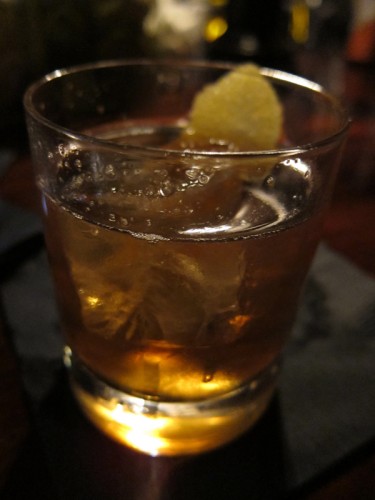Cocktail of the Day: San Francisco
Last week gave us a really fun (and somewhat raucous) evening at Seven Grand, one of our favorite bars — they had a reunion night for the entire original opening crew from April of 2007. Well, nearly; unfortunately John Coltharp, busy at his new gigs at The Tasting Kitchen and Copa d’Oro, wasn’t able to make it. It was great to see friends like Marcos Tello and Damian Windsor behind the stick there once again, though.
They brought back the entire original 7G menu for that night, too. Well, nearly; the Ramos Gin Fizz was missing (perhaps a bit too labor-intensive for a night when they were going to be slammed two or three deep at the bar), and of course the Bartender’s Choice drinks came at us left and right.
When I asked Damian for something whiskey-bearing but not on the special menu for the night, he offered this tasty variation on the Old Fashioned, or the Manhattan, or the Monte Carlo … sort of like all three fused at the molecular-genetic level inside a telepod (and with no fly, fortunately).
For the base spirit Damian chose Bernheim’s, a wheat whiskey from Kentucky made by the folks at Heaven Hill. The primary grain here is soft winter wheat (at least 51%, differing from Bourbon and rye in that those spirits must be at least 51% corn or rye grain, respectively), with some corn in the mashbill for sweetness and a bit of barley as well. It’s dry and crisp although with a bit of sweetness in the nose, full-bodied and fruity-nutty. Really wonderful stuff, and works very well in this drink where Bourbon might work less well. “The syrup takes the edge off the whiskey,” Damian says, and makes this a very well-balanced drink.
There’s a classic cocktail called The San Francisco; this isn’t it. I’m not certain if this is one of Damian’s own creations, but until he corrects me let’s say that it is.

San Francisco Cocktail
2 ounces Bernheim Straight Wheat Whiskey
1/2 ounce Carpano Antica sweet vermouth
1/4 ounce simple syrup
1 dash orange bitters
Splash Bénédictine liqueur
Lemon twistRinse a rocks glass with the Bénédictine and pour out the excess. Combine the other ingredients with cracked ice in a mixing glass and stir for at least 30 seconds. Strain into the coated glass, add a large ice cube and twist the lemon peel over the drink. Garnish with the peel.







